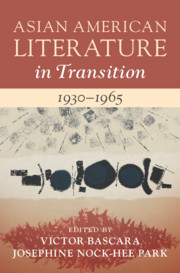Book contents
- Asian American Literature in Transition, 1930–1965
- Asian American Literature In Transition
- Asian American Literature in Transition, 1930–1965
- Copyright page
- Contents
- Figures
- Contributors
- Series Preface
- Introduction
- Part I Transitions Approached through Concepts and History
- Chapter 1 The Popular Front and Asiatic Modes of Cultural Production
- Chapter 2 Asian American Realism
- Chapter 3 On Modernism, Decolonization, and Asian American Literature in Transition
- Chapter 4 The Cultures of Japanese Internment
- Chapter 5 The 1947 Partition, War, and Internment
- Chapter 6 Cold War Fiction
- Chapter 7 Desert, Island, Ocean, Swamp
- Part II Transitions Approached through Authors, Texts, Concepts, and History
- Select Bibliography
- Index
Chapter 6 - Cold War Fiction
The Flower Drum Song’s Political Education
from Part I - Transitions Approached through Concepts and History
Published online by Cambridge University Press: 27 May 2021
- Asian American Literature in Transition, 1930–1965
- Asian American Literature In Transition
- Asian American Literature in Transition, 1930–1965
- Copyright page
- Contents
- Figures
- Contributors
- Series Preface
- Introduction
- Part I Transitions Approached through Concepts and History
- Chapter 1 The Popular Front and Asiatic Modes of Cultural Production
- Chapter 2 Asian American Realism
- Chapter 3 On Modernism, Decolonization, and Asian American Literature in Transition
- Chapter 4 The Cultures of Japanese Internment
- Chapter 5 The 1947 Partition, War, and Internment
- Chapter 6 Cold War Fiction
- Chapter 7 Desert, Island, Ocean, Swamp
- Part II Transitions Approached through Authors, Texts, Concepts, and History
- Select Bibliography
- Index
Summary
This chapter explores the expressive possibilities of the early Cold War era by reconsidering C. Y. Lee’s pathbreaking 1957 novel, The Flower Drum Song. Adapted into a Broadway musical in 1958, a Hollywood production in 1961, and then revived on stage in 2002, Lee’s breezy tale has been a source of fascination and vexation for Asian American audiences for decades. This chapter’s reading resituates Lee’s novel within postwar US–Asian relations and the position of Asian America in the early Cold War period in order to reconsider The Flower Drum Song as an exhibit of the narrowed political parameters of the Cold War consensus. In focusing on the political machinations featured in Lee’s novel – and not its afterlives – this chapter reads a critical opening for Asian American expression, but on straitened political terms. At the heart of The Flower Drum Song is a political education that reasons through the necessity of anticommunism; and though the astonishing success of The Flower Drum Song and its adaptations has been taken as evidence of successful domestic incorporation, the exigencies of the postwar political order are on full display in the novel, which both obeys and ironizes Cold War strictures of thought and feeling.
- Type
- Chapter
- Information
- Asian American Literature in Transition, 1930–1965 , pp. 108 - 122Publisher: Cambridge University PressPrint publication year: 2021

